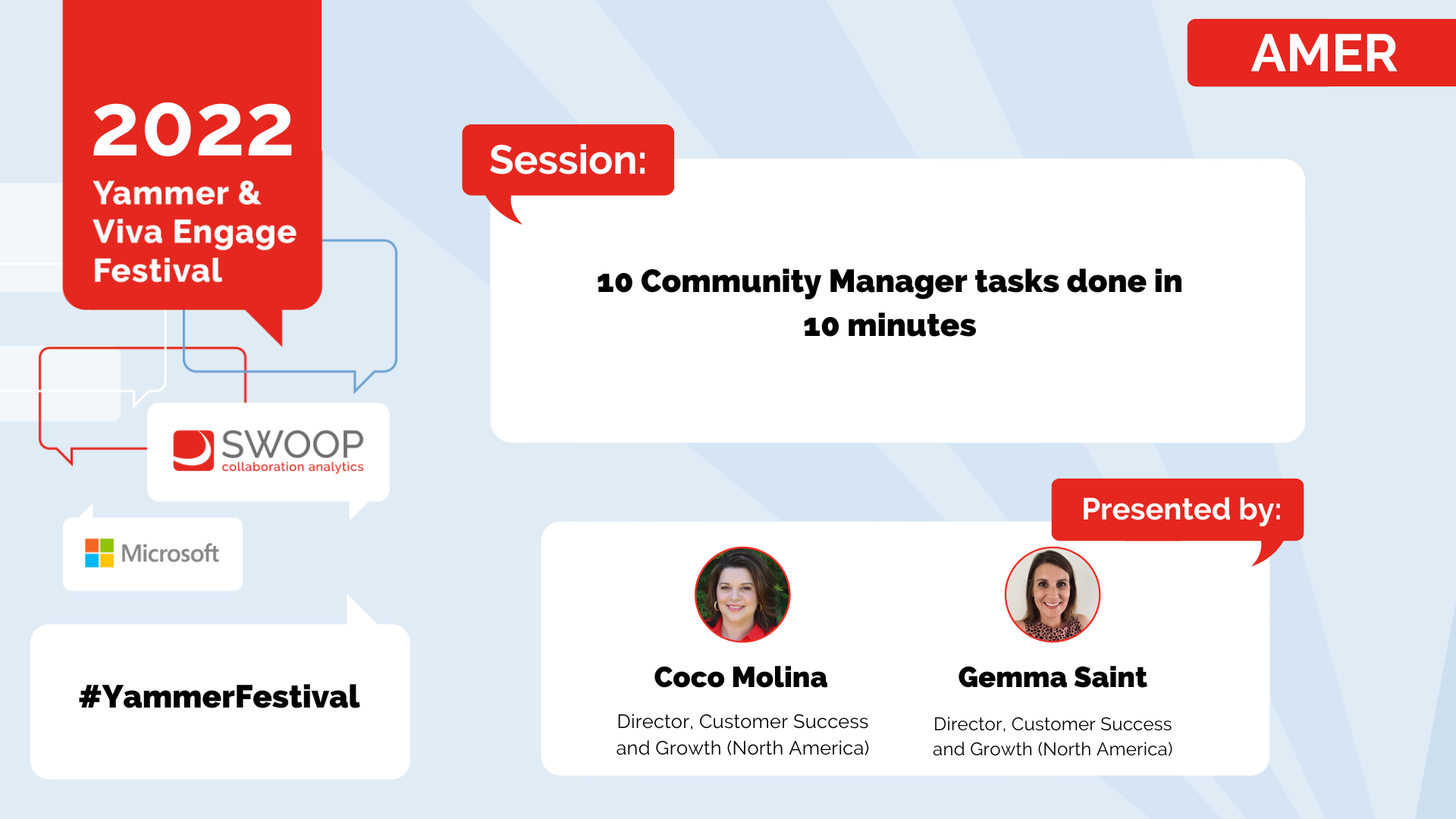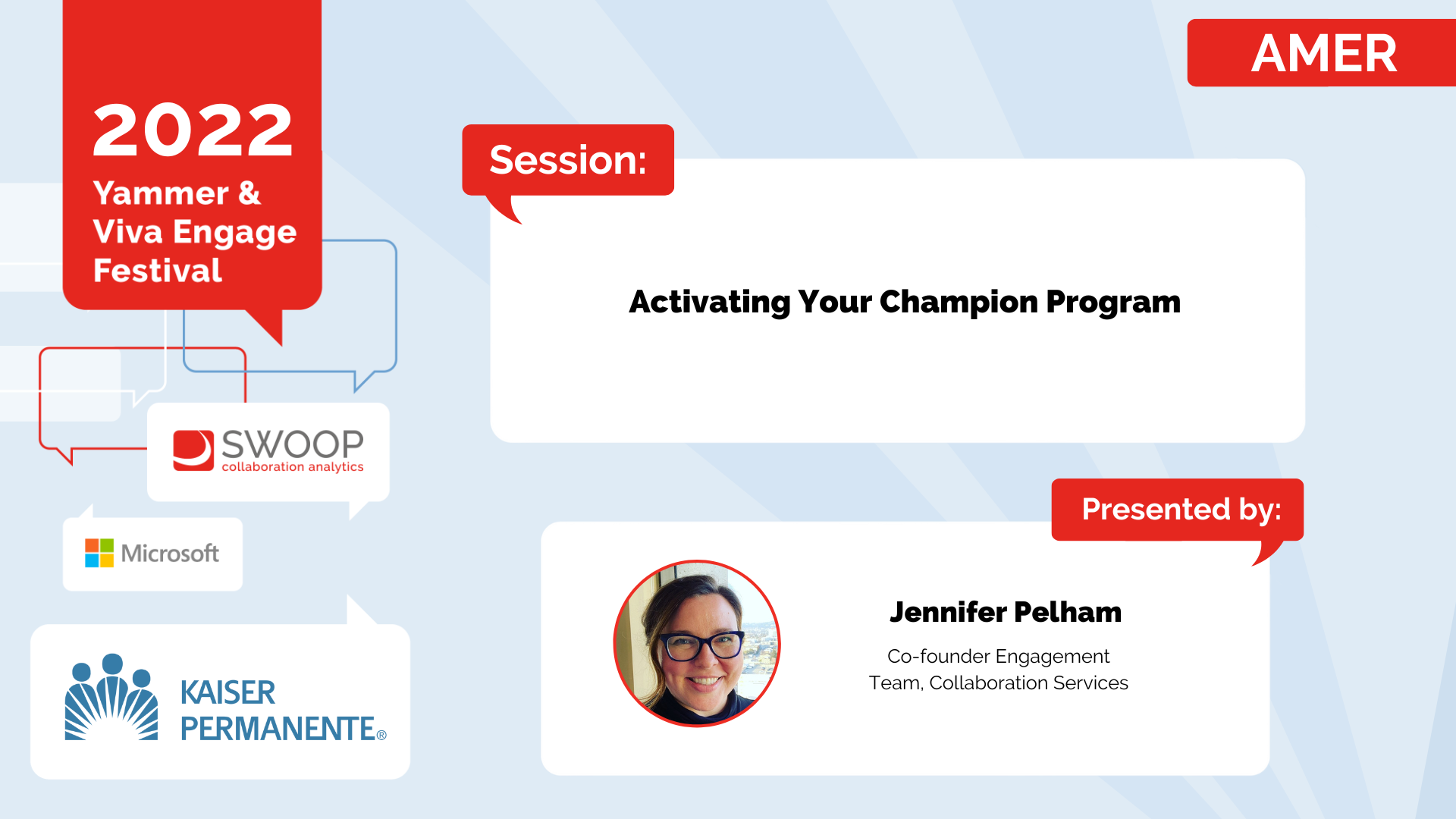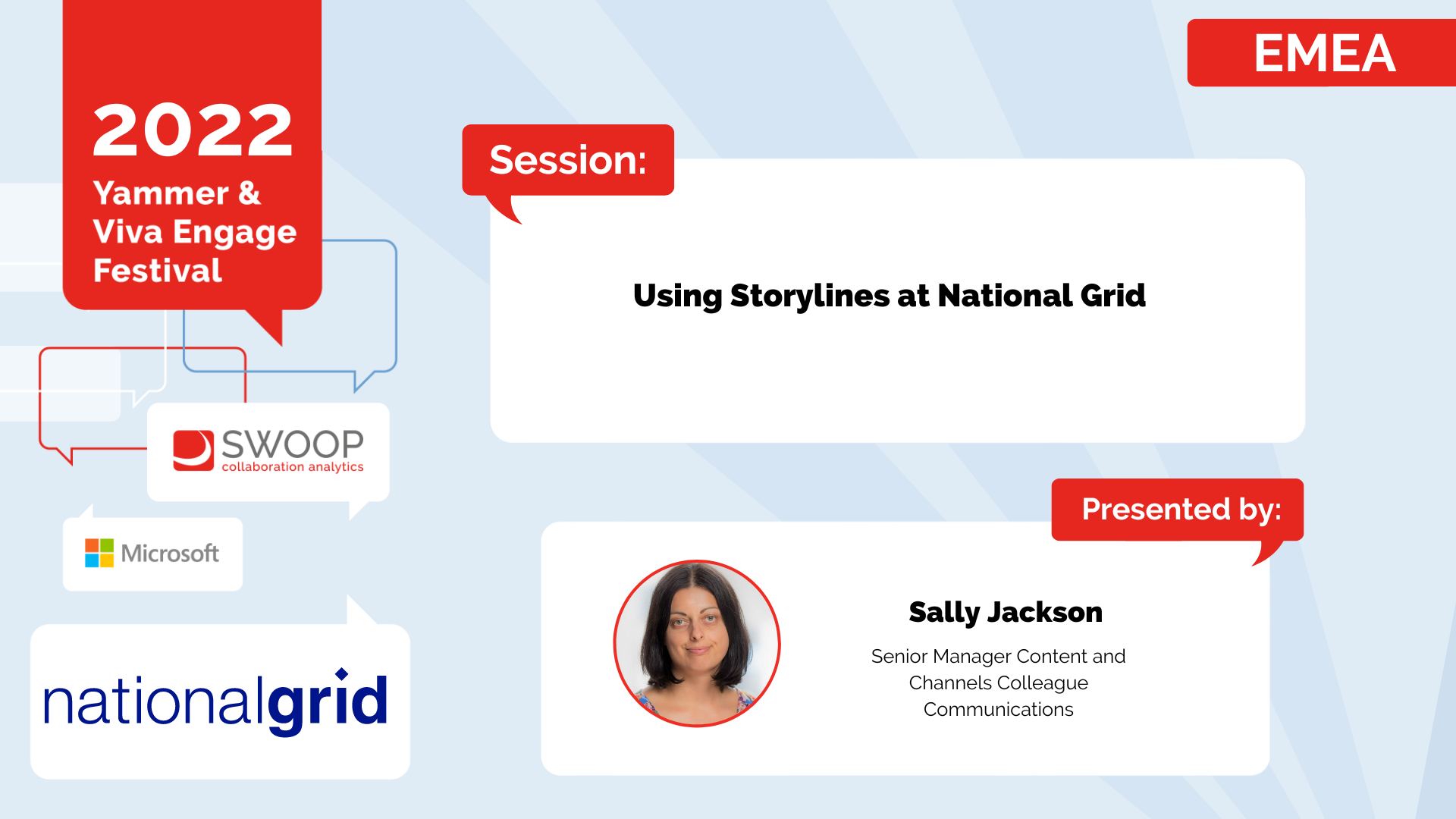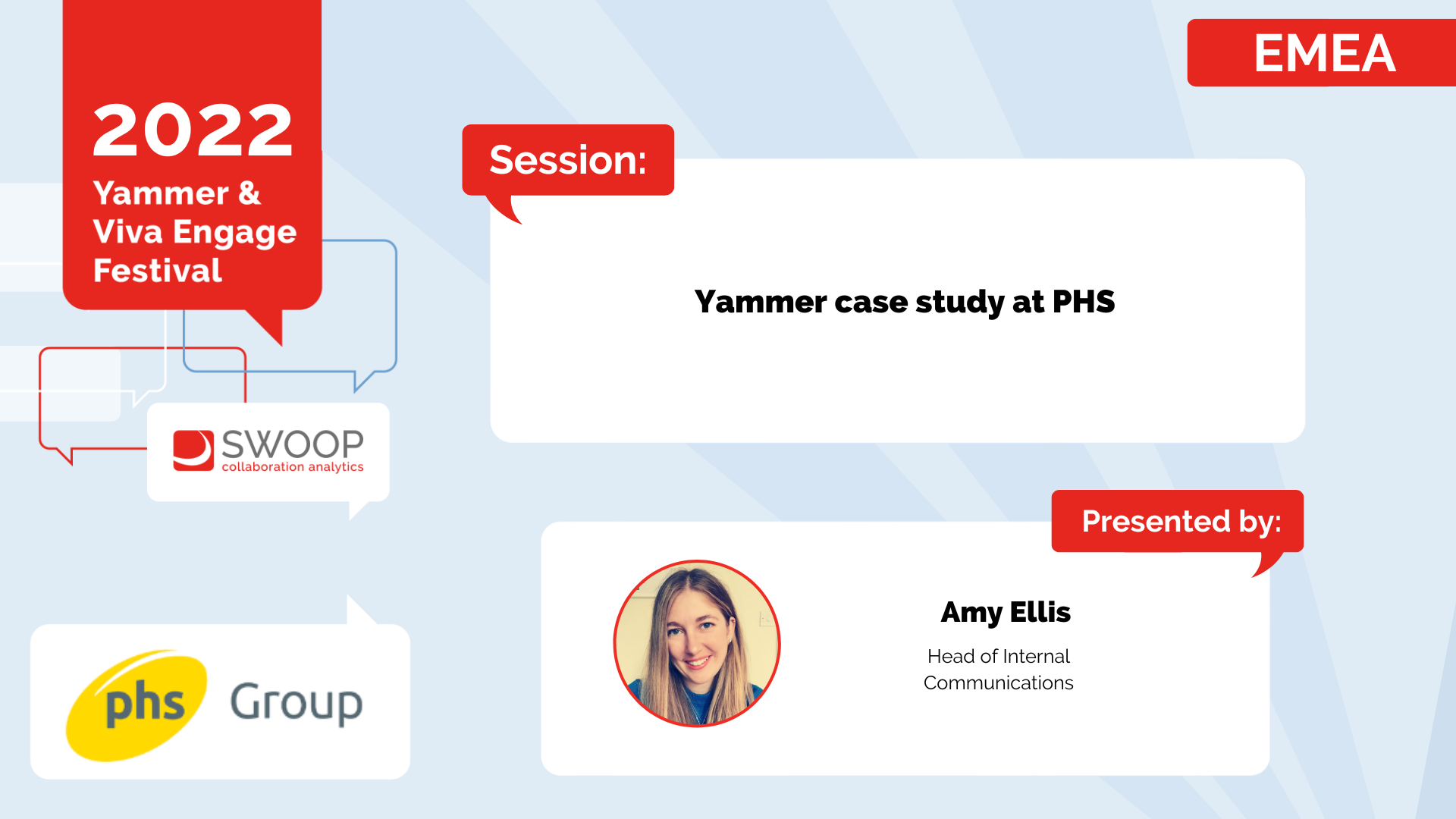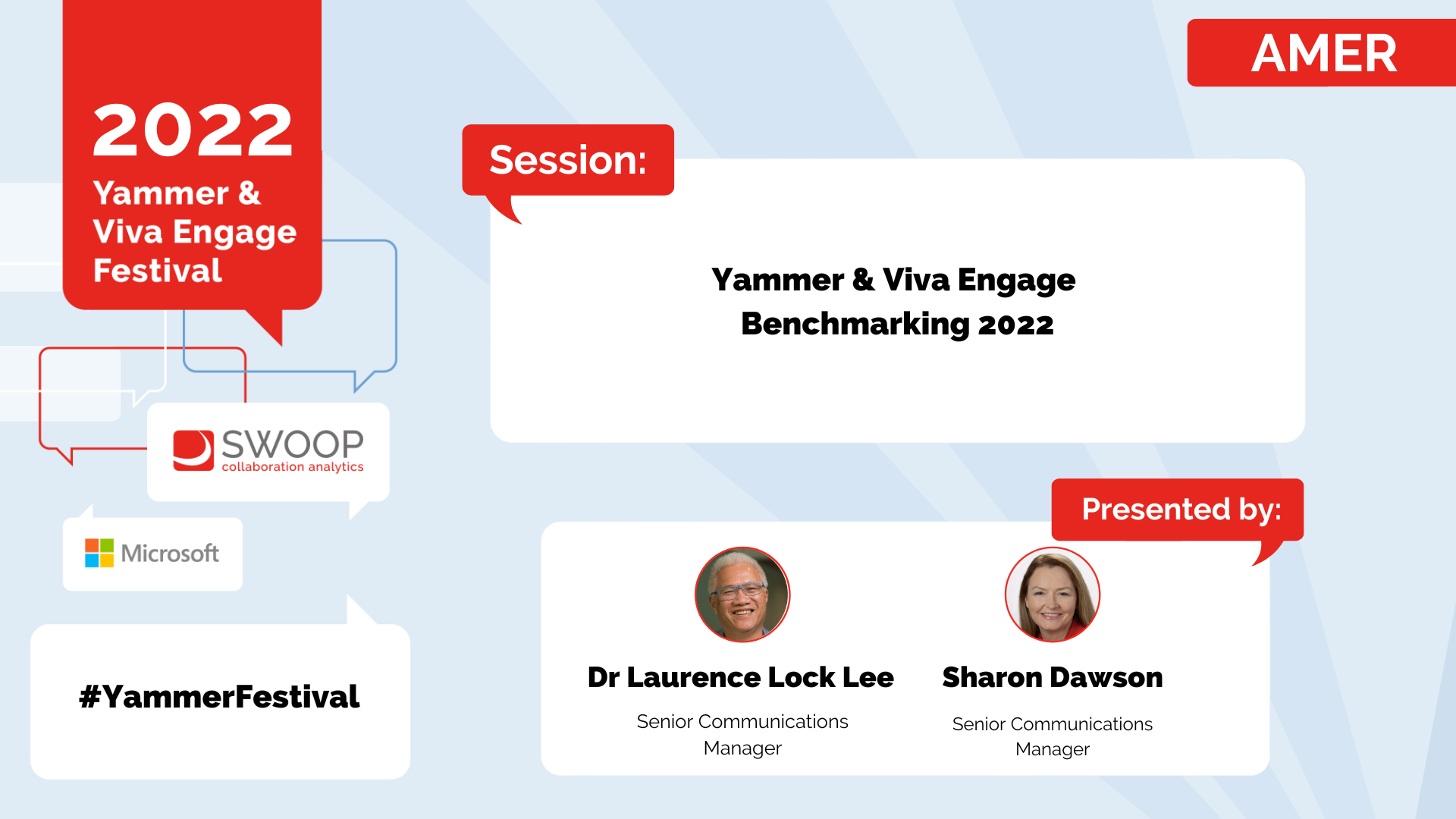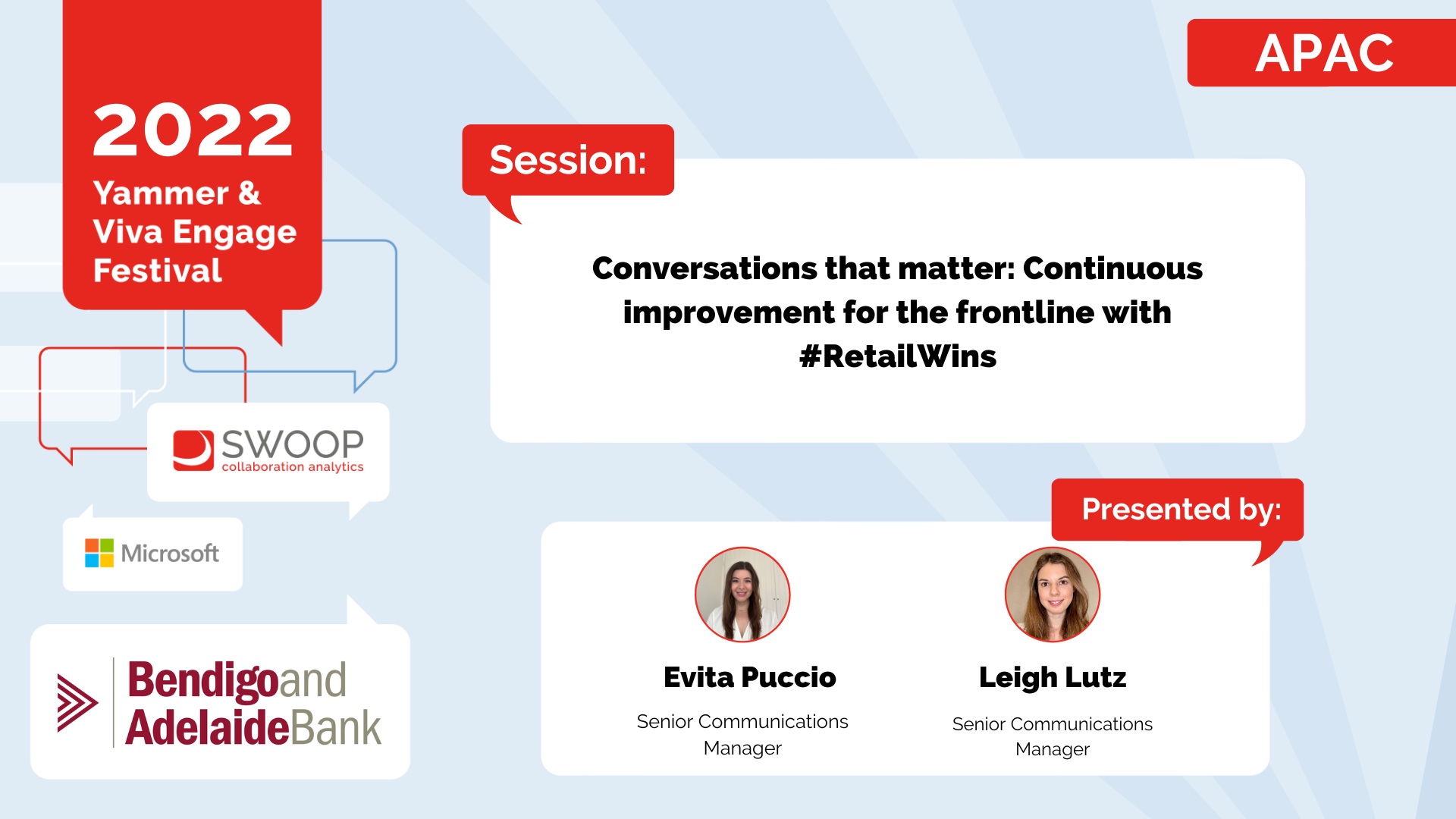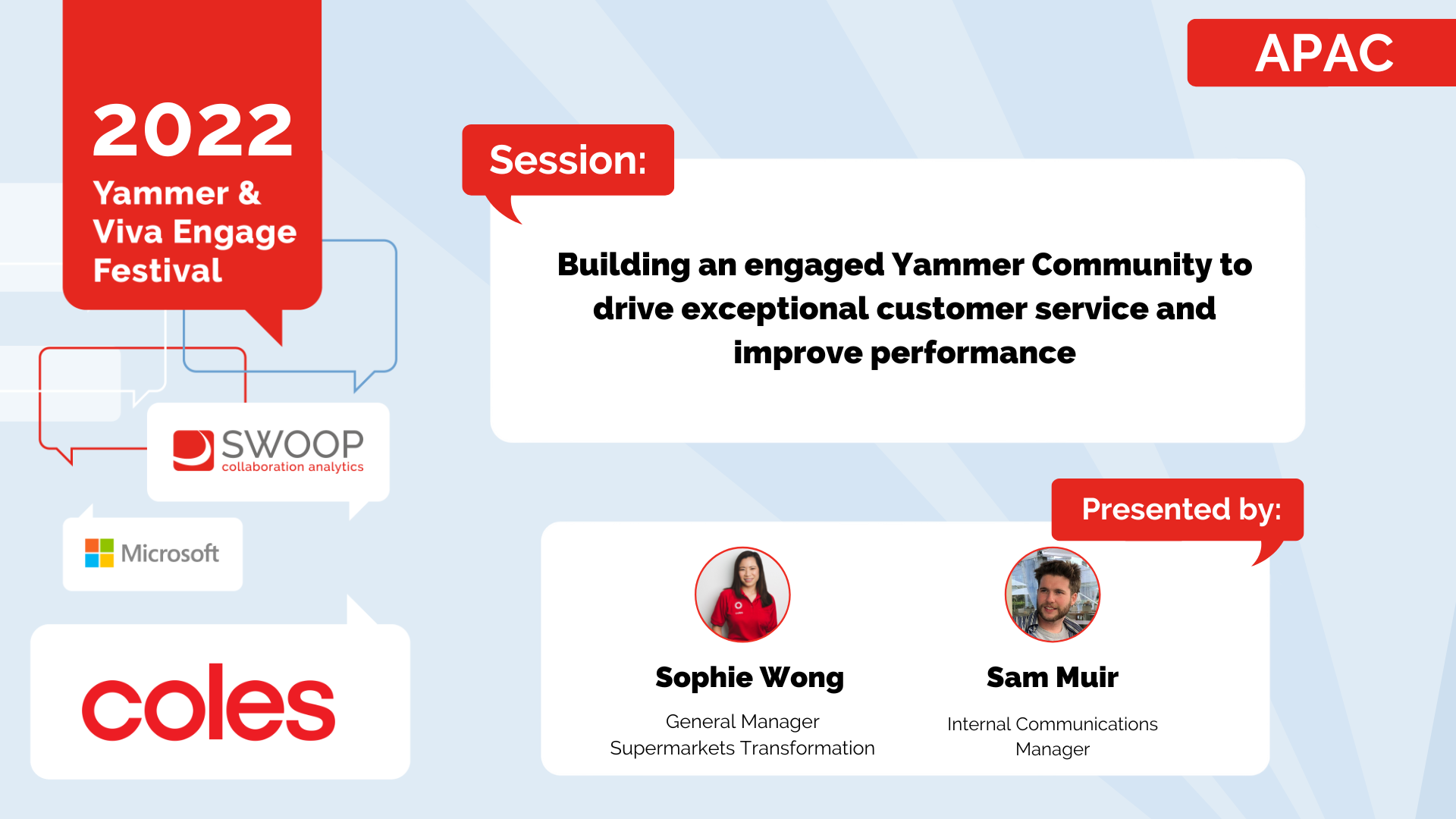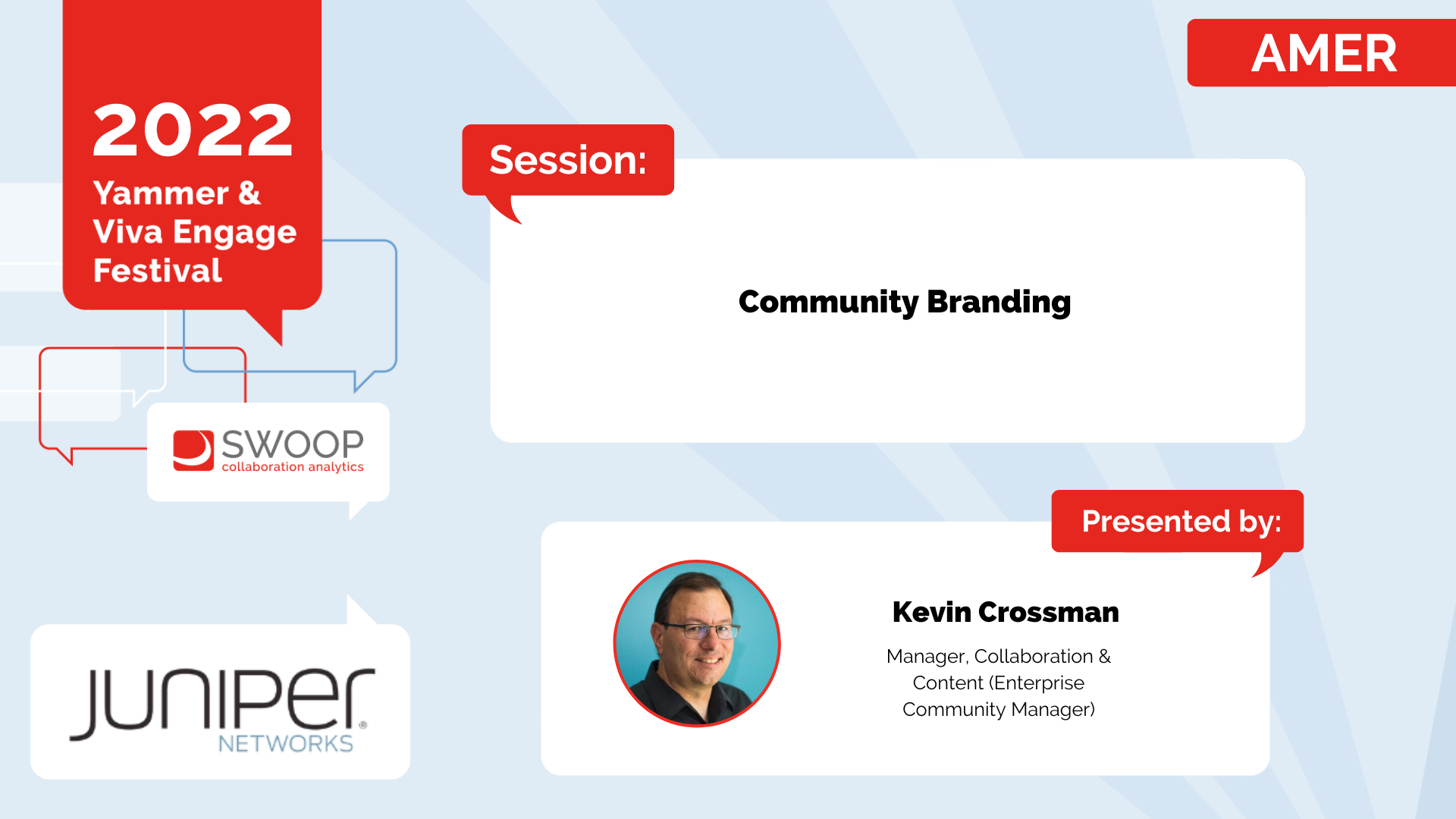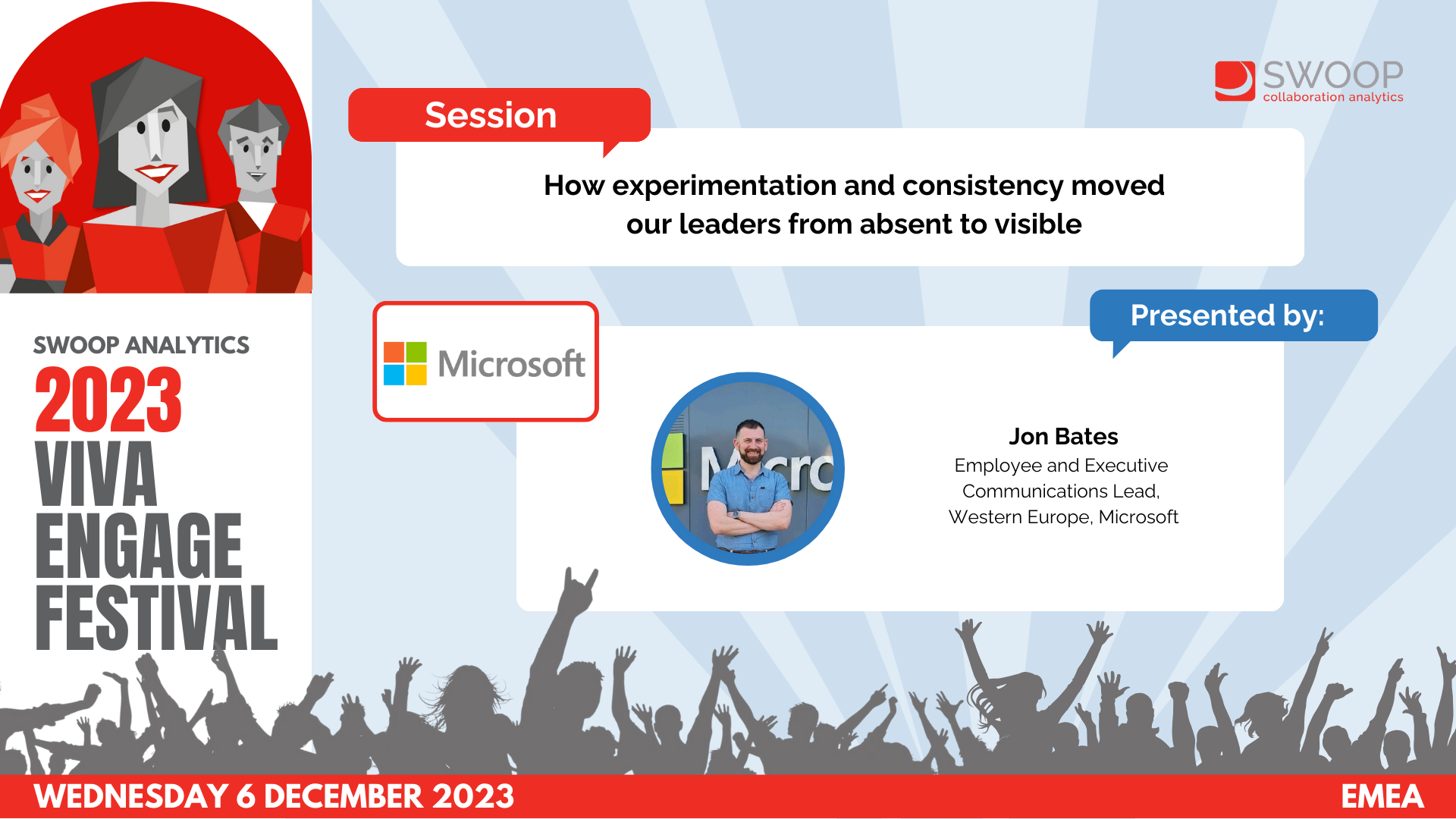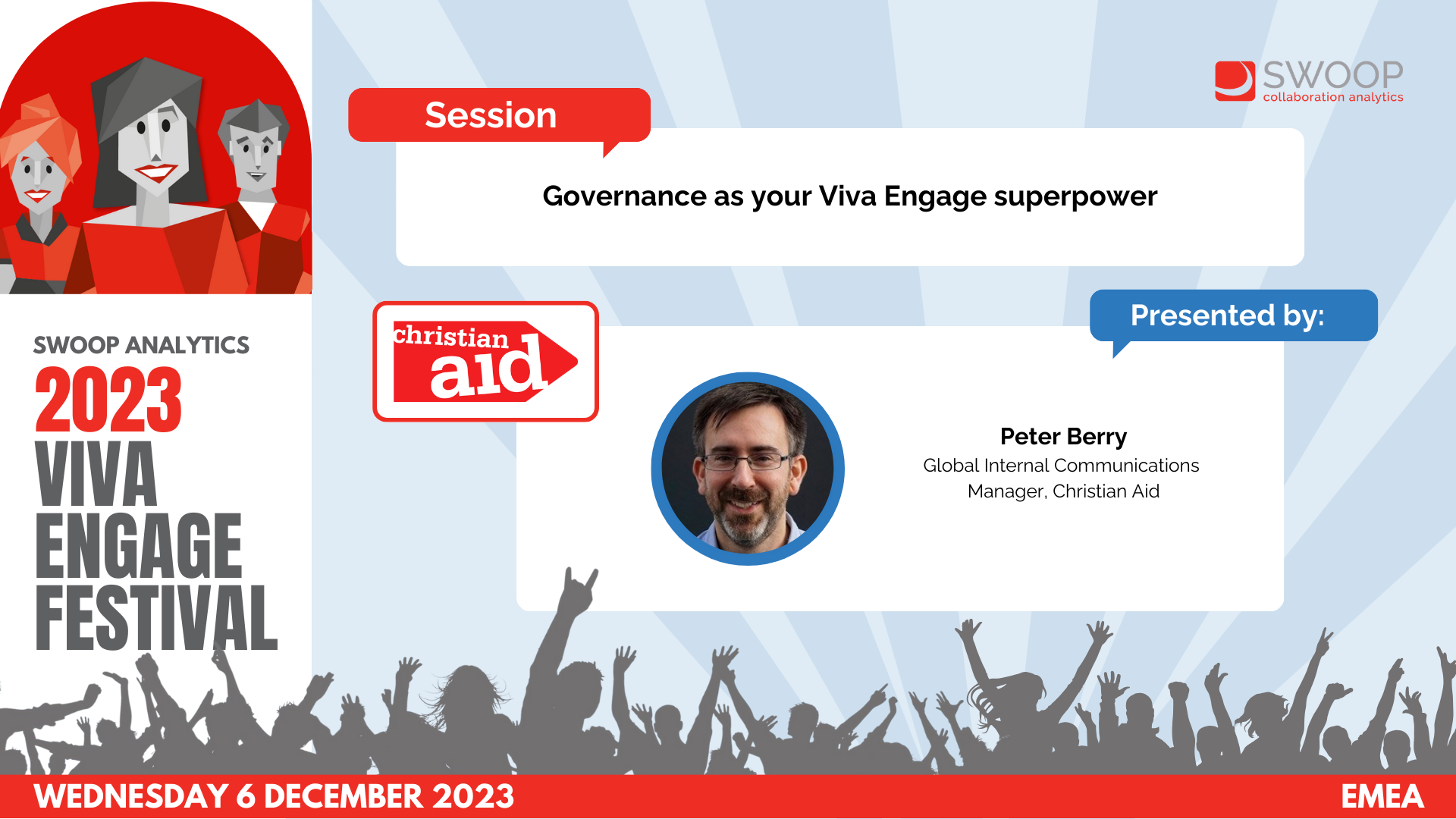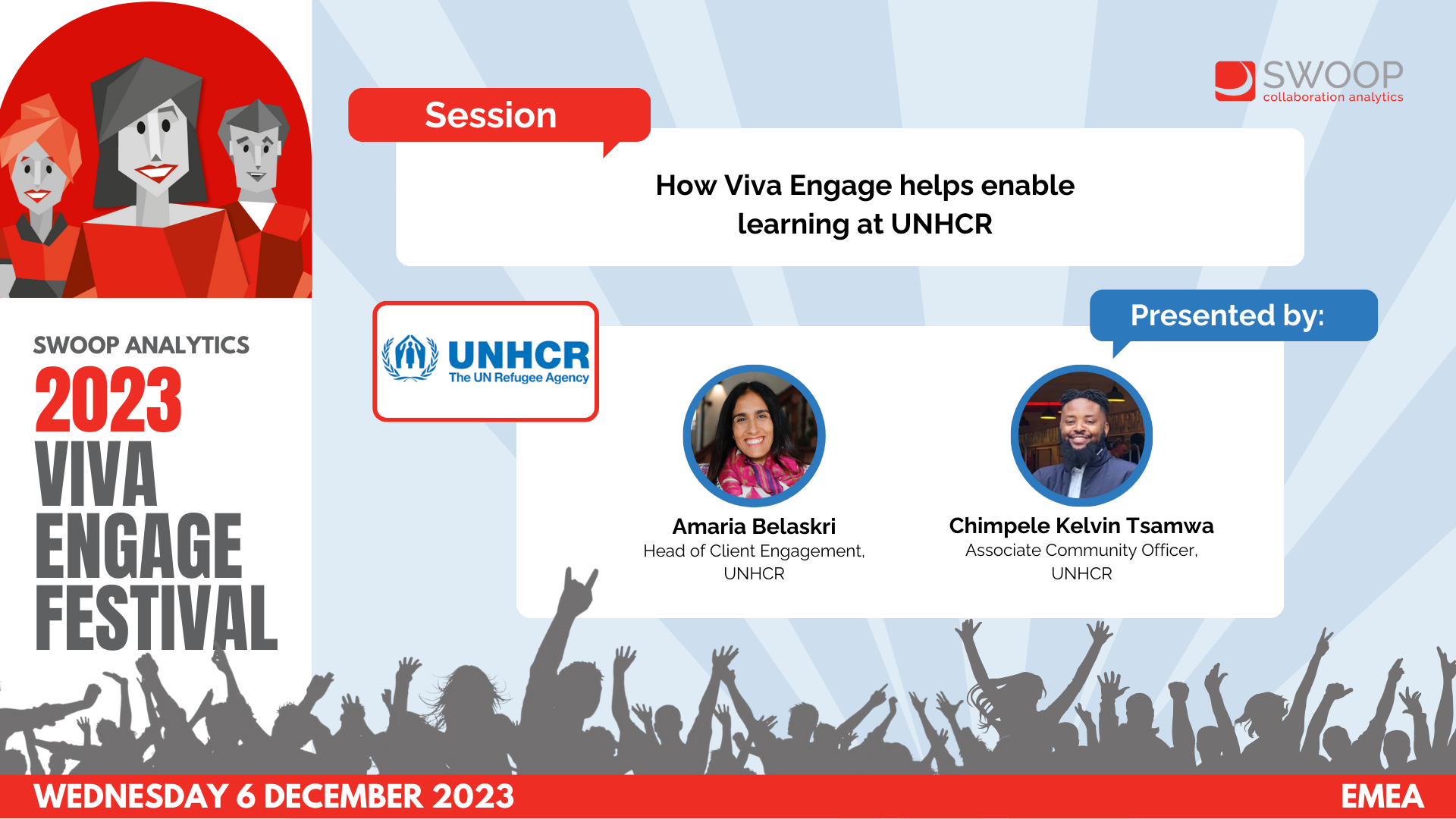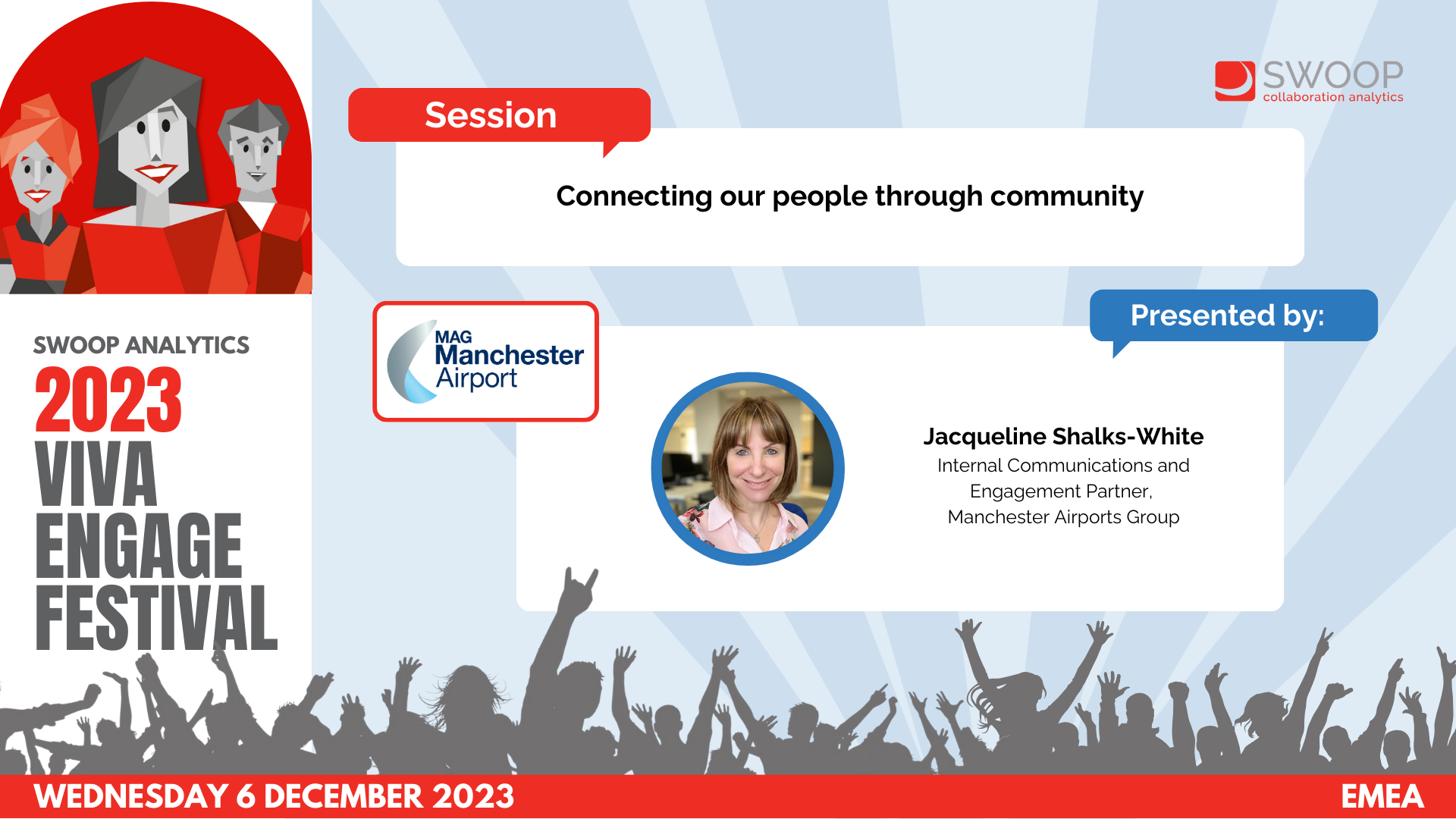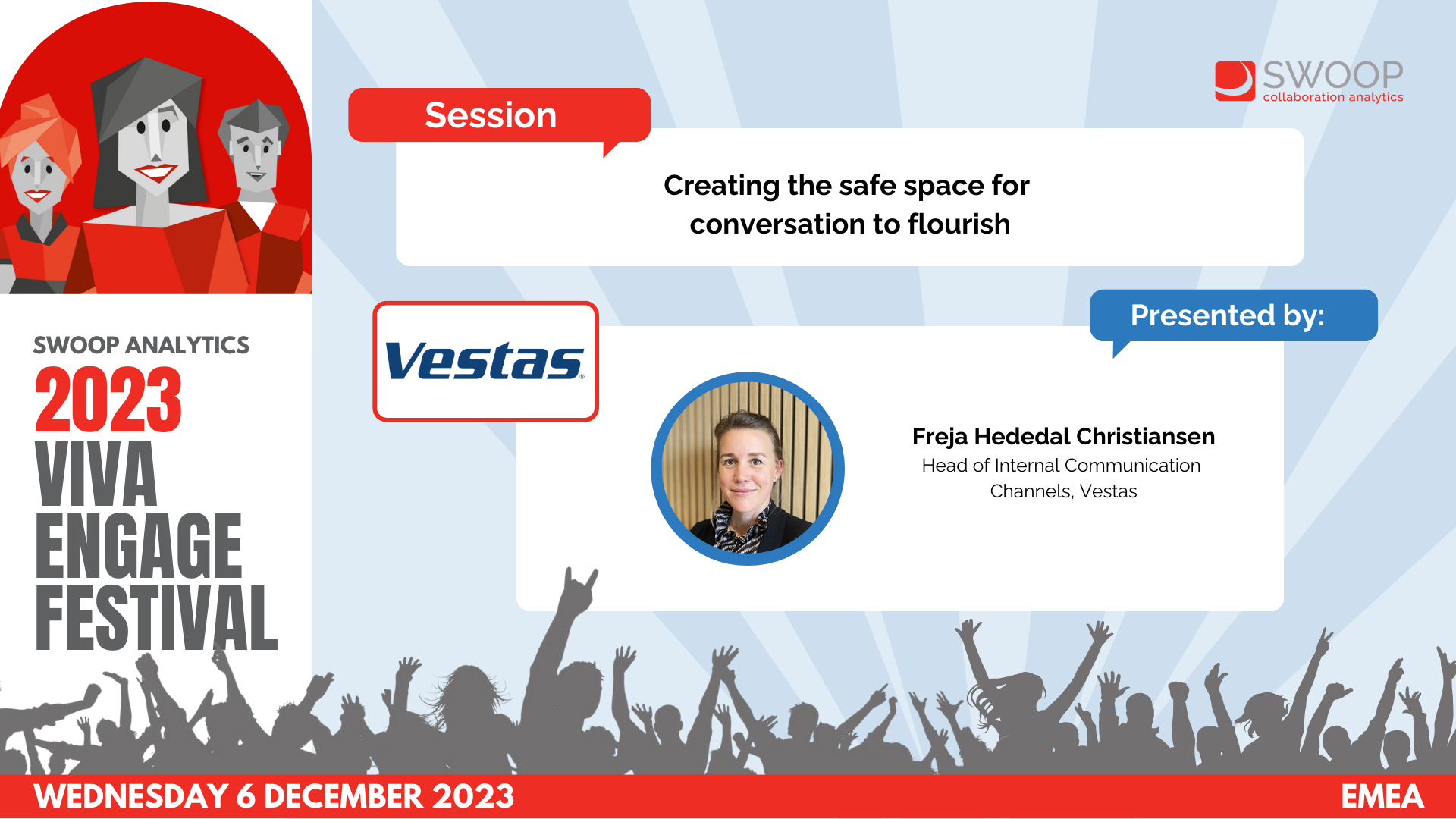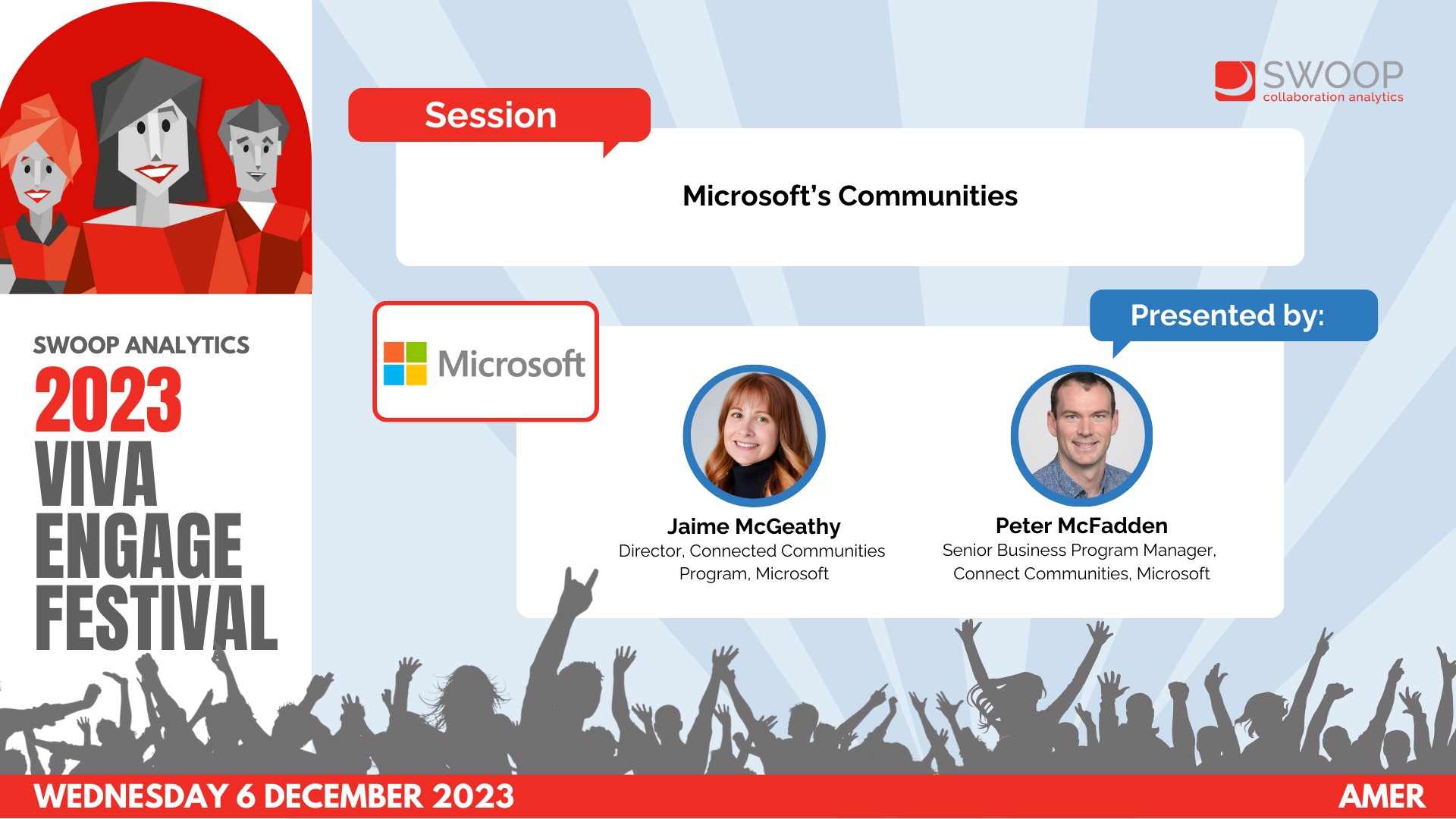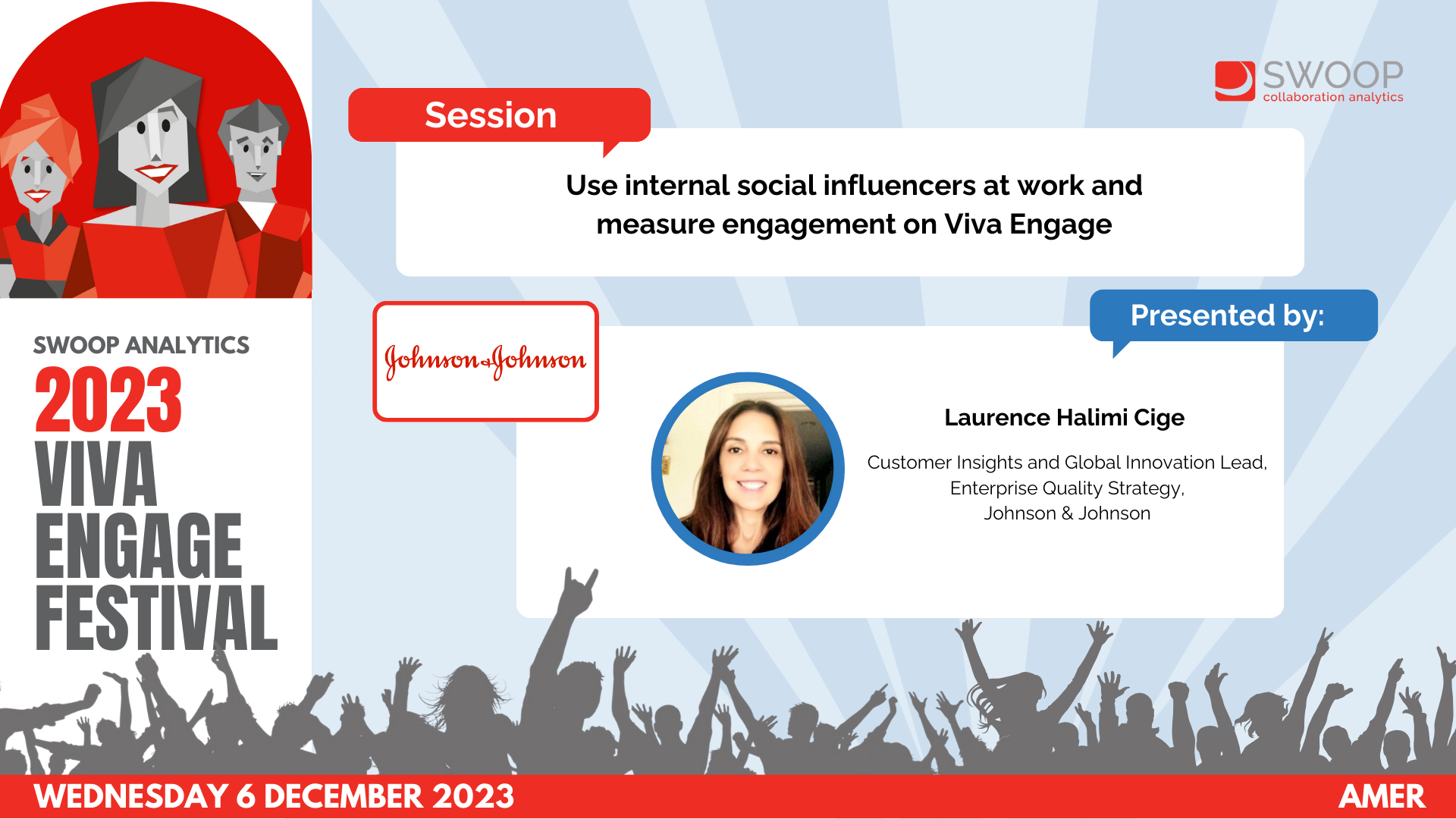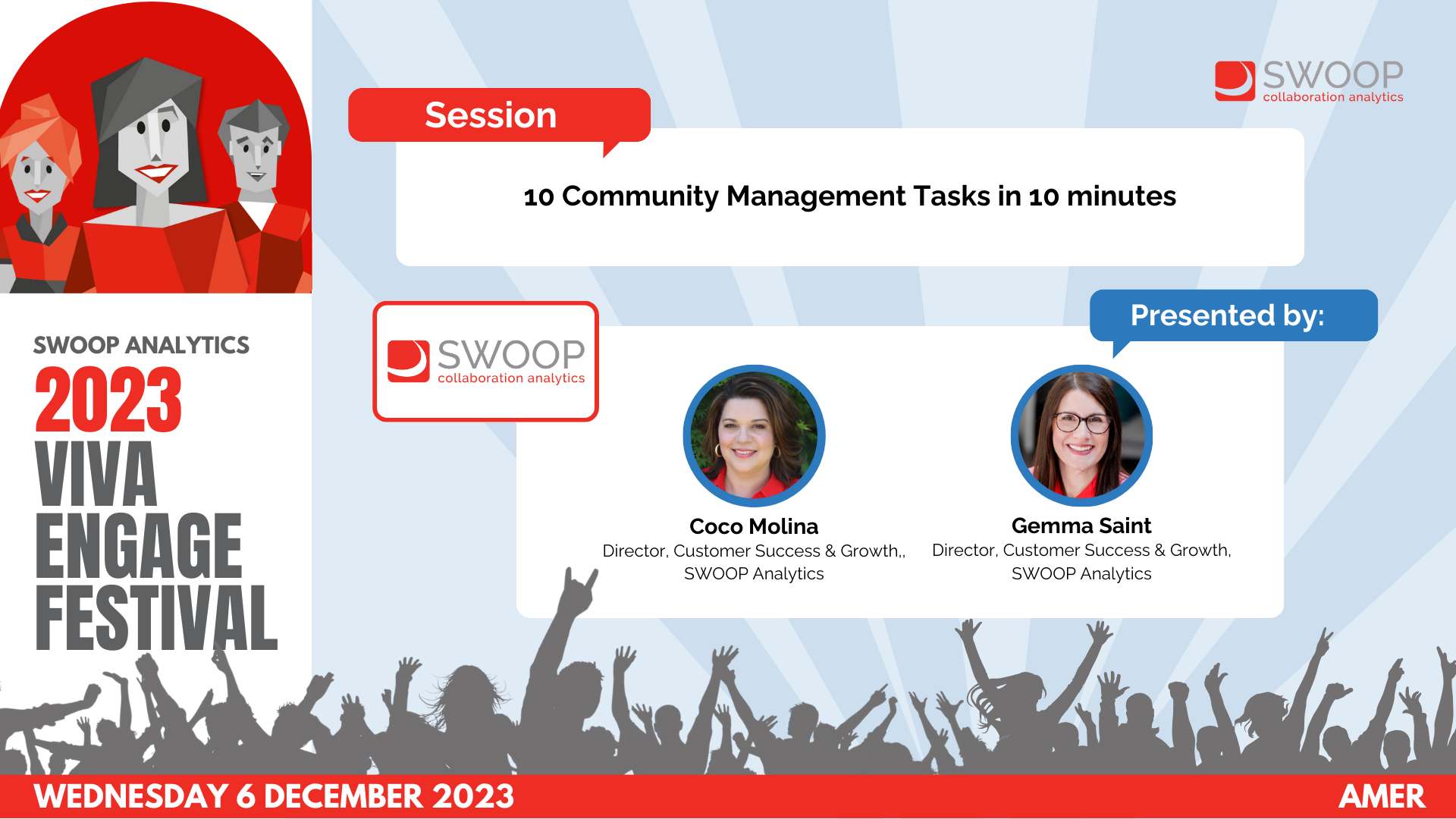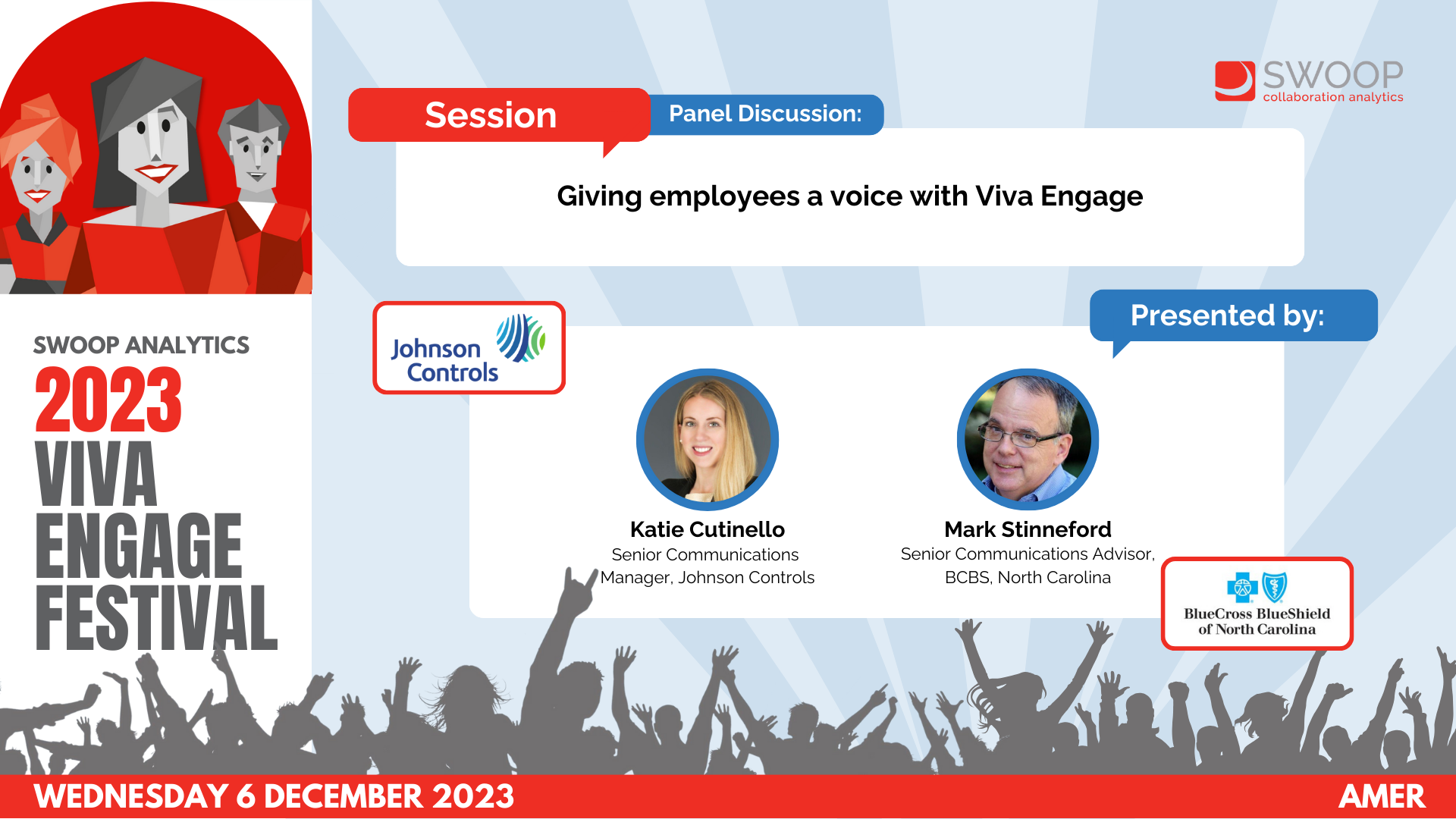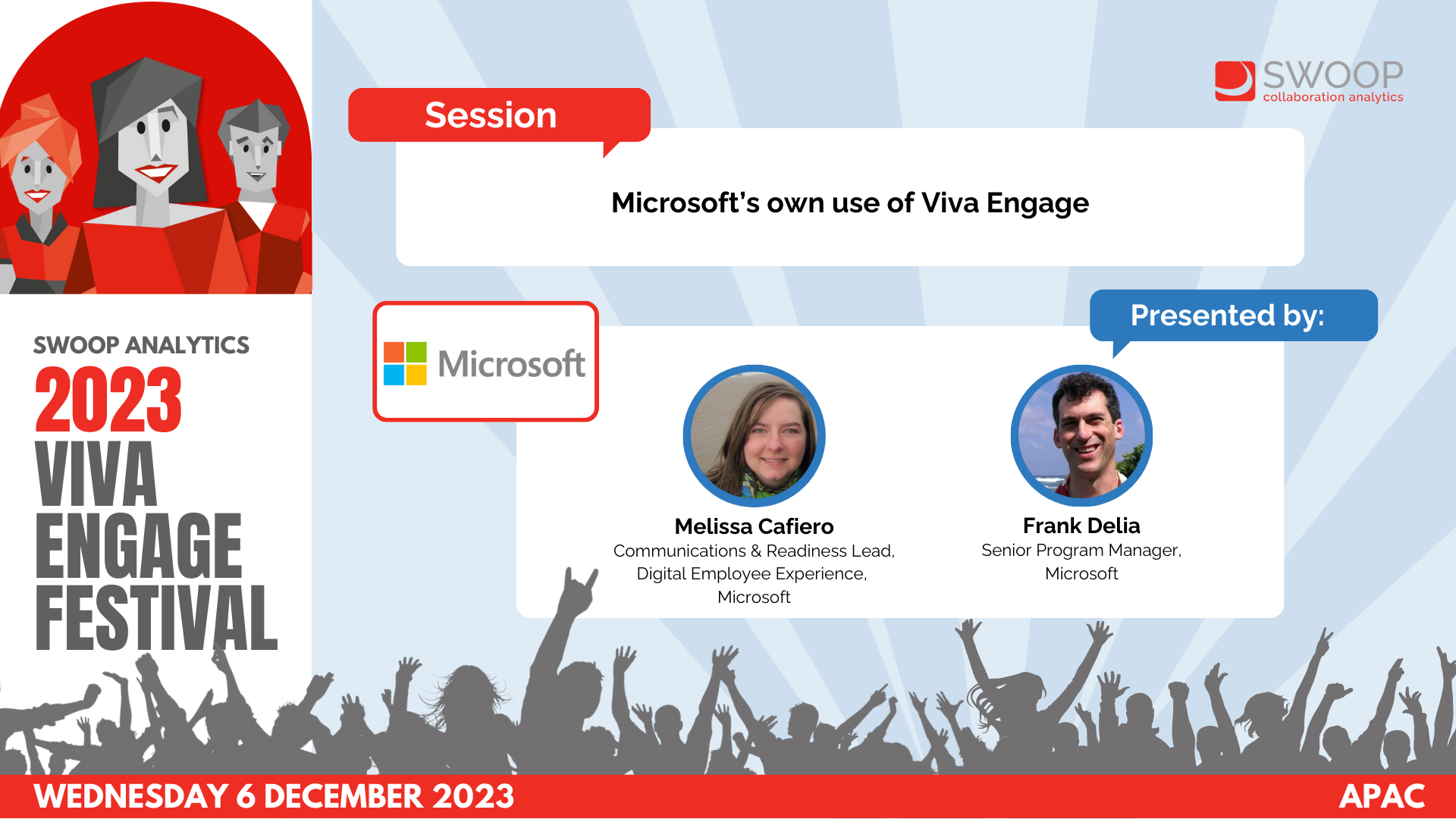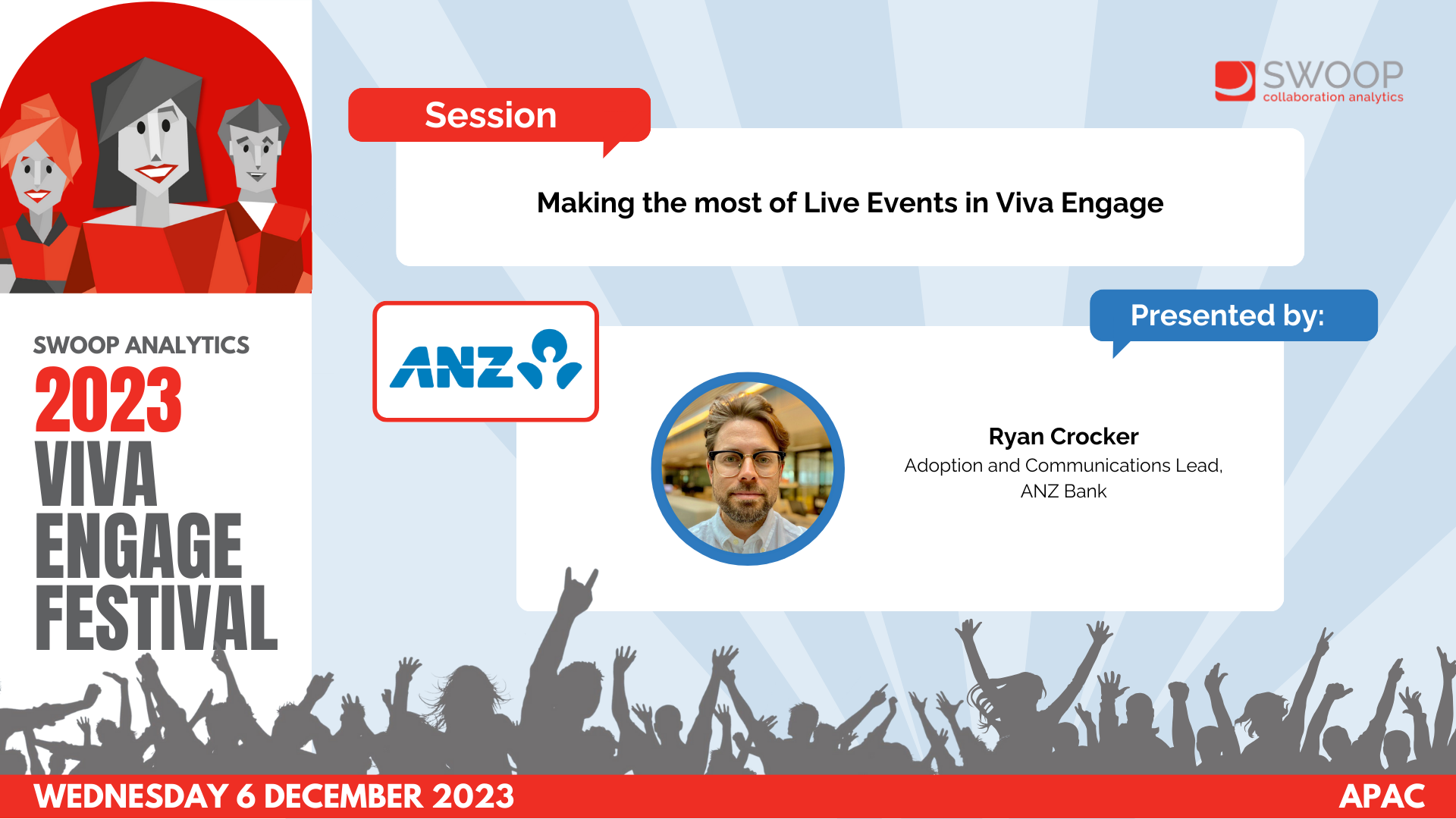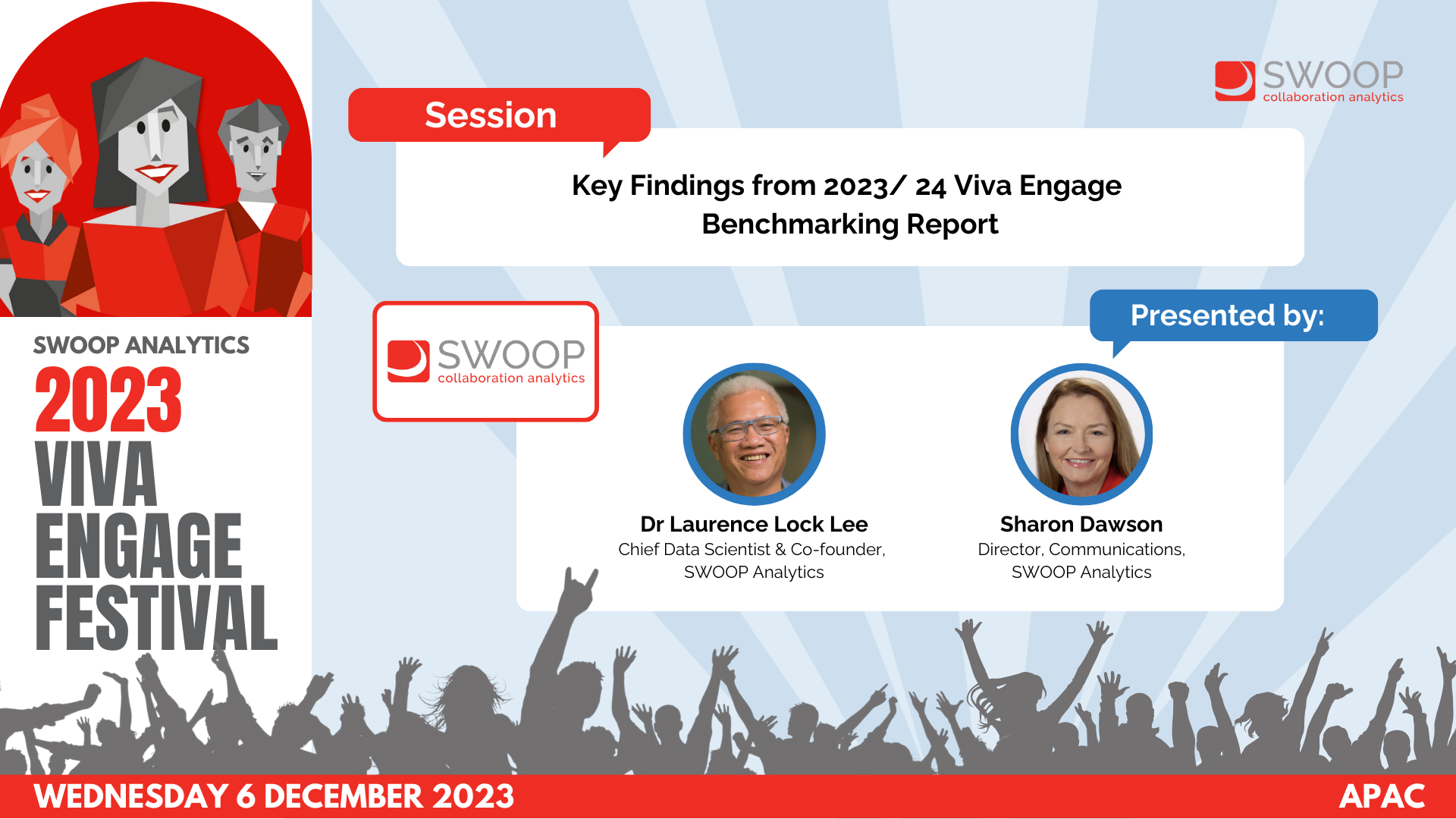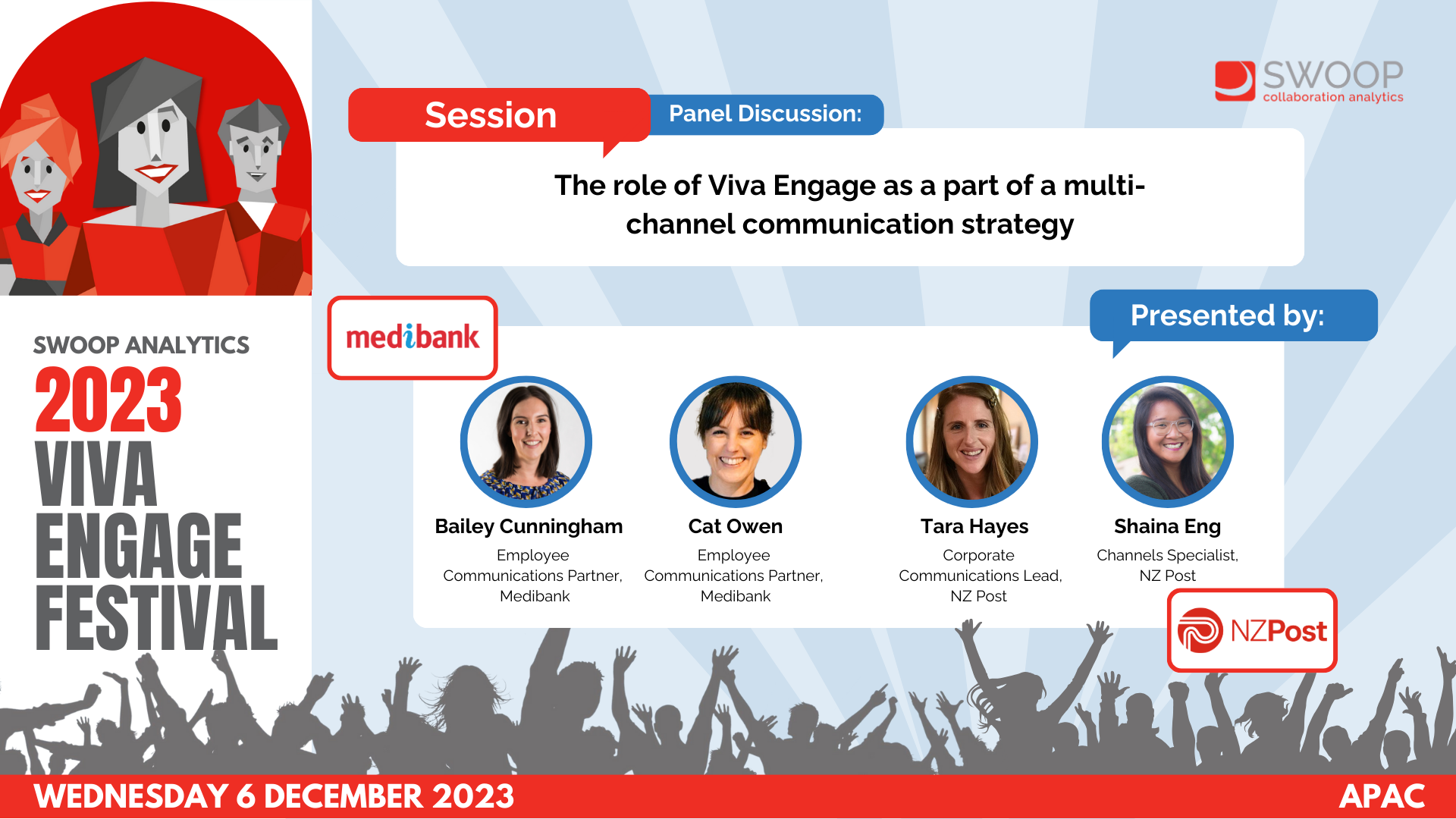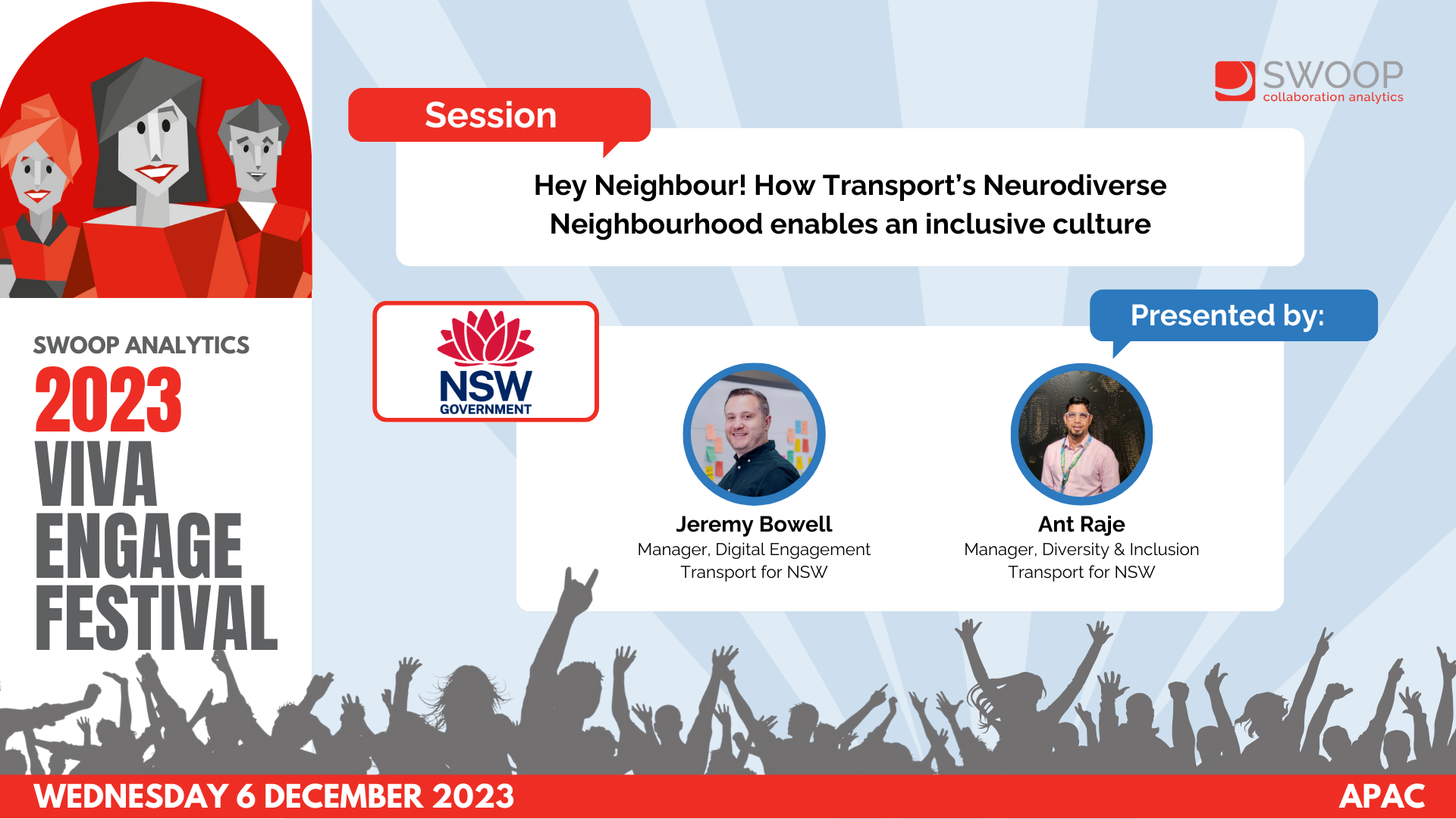Suncorp: Choose your own (Yammer) adventure - How allowing employees to decide their destiny doubled Yammer use
APAC | Yammer & Viva Engage Festival 2022
Learn how Sammy Howarth from Suncorp uses Leaders and Communications and Change advisors as primary influencers, the team shares their success in their creation of ‘choose your own adventure’ style communication resources, as well as their tailored communications tactics, resulting in nearly double the number of active users on the platform in as little as 18 months.
-
Yeah, thank you again for having me and for coming out the next 20 minutes of your time. Before I begin, I'd just like to give a quick acknowledgement of country and extend that acknowledgement to elders past, present and emerging and those joining us here today. I'm presenting to you from our beautiful ADN street location in Brisbane, and that's also the country of the Yagara and Turrbal people.
And for those, anyone who's joining us today who might have some accessibility issues, for you, I am wearing my favourite bright pink shirt. I'm in a beautifully lit room in my office and I have dark brown hair and glasses. Okay, so a little about me.
I'm a communications and channels advisor in the employee communications and community team at Suncorp Group. I work in a small team of two channels specialists, including myself, and our roles are primarily around optimising our existing employee channels like the intranet and Yammer, which obviously I'm going to talk about today, and implementing change management and communication strategies for new channels in our digital workplace. This year, we were very fortunate to have our in-house Yammer strategy recognised for its success in Step 2's Intranet and Digital Workplace Awards, in which we won gold for the social and collaboration category.
So, I want to start by acknowledging that this work was created and reached success, certainly not just by myself, but also by my really talented colleague, Susan McAndrew, who I think is here today. She's my partner in crime at Suncorp in our small channels team of two. Susan and I worked on the strategy and execution of this Yammer strategy for a bit over a year, but spent a lot of the time in that project simply trying to understand our audience, and I suppose that's what's brought us to where we are today.
And we just wanted to share a little bit about where Susan and I sit in the whole Suncorp people realm. This is sort of our mini structure of where we sit in Suncorp, and that's how many people we've serviced with this Yammer strategy. 23,000 employees, and with 13,000 of those are onshore.
So, Susan and I were recently asked to speak in another conference I'm sure some of you would have attended, which was the DEX Step 2 conference about that award-winning Yammer strategy. And since that presentation, I've really reflected upon how genuine the content that we delivered was. Our presentation was titled Suncorp's Guiding Principles for Managing the Internet as a Product, which to me is just a fancy way of saying how we achieved so much with so little, referring to both our team and our budget, which was zero dollars.
And one of the main principles that we reflected on in that conference, and that I really feel underpins our entire Yammer strategy, is that last point here on the slide. Our change communications are highly targeted and tailored group to group. That's what underpinned this whole strategy and what I feel really brought us to our success.
So, for our strategy, there wasn't a one-size-fits-all solution. By the time we picked up Yammer and created our adoption strategy in 2021, we started in maybe February, Yammer had been embedded in the Suncorp environment for almost seven years. So, in 2014, it was sort of plonked into the environment without context.
Communications are a change program, and by the slide before, we don't need to tell you that approach doesn't really fly in Susan and my little team. We like to do things in a very measured approach. So, when we approached this communication strategy in 2021, we really wanted to start fresh.
And as you can imagine, because there was no communications and change strategy at the time in 2017, adoption was really low when we picked it up. It was sitting at about 40 active participants in Yammer, and mind you, we were using very basic measurement tools like Power BI. So, active isn't active in the sense that you would see it in SWOOP Analytics.
It was active as in people had visited the platform semi-recently and looked at stuff, as opposed to interacted, commented, reacted, or posted. So, we had really low engagement with leadership posts, little interest from leaders themselves to post, and a lot of blasting behaviour occurring from our communications and change roles. And they weren't really tailoring their content to the platform either.
And the behaviour shown from our employees' interaction with the platforms and their interactions on other platforms in the environment proved to us that our strategic approach needed to be focused on a custom offering tailored to each role type in our organization. And I suppose that's where we started to develop this idea that people could really choose their own adventure in Yammer and how they wanted to use the product. On this slide here, I've just got a quick indication of where we basically started in 2017 – sorry, excuse me, in 2021 when we picked up the – when we started to implement the strategy.
We have a communications survey from 2018 which asked people how valuable they found Yammer. Frighteningly, 46% of that group said it is never valuable. And that just gives a quick indication on the right of how many active and inactive participants, by that description I gave you earlier, were on the platform at that time.
So yeah, pretty scary stuff that we were walking into, but nonetheless, we were determined and it paid off. So what did we do? We – our strategy. We researched our employees' behaviours even further and ascertained each group's sentiment towards the platform.
And not only did we ascertain the group's perceptions towards Yammer, but we assessed all our communications channels in the Suncorp Digital Workplace and really tried to understand what kind of content people were interested in, who the content was coming from, and how that made an impact on people's reactions, open rates, click-throughs, etc. We also developed an understanding of each group's technological maturity, needs, wants, barriers to usage of Yammer. We looked at tried and tested methods of adoption usage cases in not just our organization, but others too.
We were really lucky to sit down with a couple of our peers from other organizations and sort of brainstorm the strategy and try and test it and work with those people on what worked for their strategies as well. We didn't want to be overly confident about our strategy. We wanted to make sure we were getting best practice right, and I always think it's very healthy to question yourself in that sense.
We looked at content, as I mentioned, that was performing well to understand what employees were actually engaged with. We enabled ease of access to tailored resources that worked any which way employees chose to learn, and I'll go into that a little bit in the few slides. We selected key groups that held serious influence in the organization, and we skilled them up first, and we nurtured, listened, and responded to the feedback given throughout the strategy.
So just a little bit, right? We did a lot, but we really feel that this long-held strategy was really worth it, and I'll sort of talk to you about some of the things that we felt took a lot of time at the time that we implemented the strategy and those tactics, but really were game changers for us when we looked at the results this year. So we're going to take you through some of those tactical examples of how we've achieved nearly double our active users rates on the platform, and again, we utilized no budget for this and just the resources we had on hand. So before I dive into exactly what we did with our research, I just want to tell you about what we discovered about our users, because this is kind of the reasoning behind the entire strategy, and we'll give you an idea of why we did what we did.
Like I said before, this won't necessarily work for every organization, so I think it's really important to understand specifically what works best for your organization, and that's what the research really told us. So senior leadership, when they were associated with Yammer, posting selfies that weren't particularly edited, or if they were posting announcements even, the verbatims were quite positive. So this differed from the overall comments about Yammer, and that tended to polarize respondents.
More exposure of Suncorp senior leadership was desired by employees, and there was a desire for more communication from these figures across all platforms. The timeliness of existing communications was less favourable than the content of the communications themselves, which were mostly received positively. Communications from the perspective of leaders, so we have this news content on our SPARC home page which is called In the Business, which is almost like a thought leadership piece, and people went crazy for it.
They absolutely loved that content coming through. So not all organizations, and I know particularly some organizations that I've worked for, people aren't mad on a lot of the communications coming from leaders, but at Suncorp it's something that's really thrived upon, and people really crave that interaction, and that, you know, the sort of ambitious tone coming from leaders, it really inspires our people. So yeah, this was a really clear theme coming through the research.
Like I mentioned before, those selfies, pictures at home, leaders getting vaccinated, and that's regardless of the professionalism of the image, and I'm sure you all know this, like Yammer's all about authenticity. So yeah, that kind of post on Yammer was getting more engagement than any other type of post on the platform. We learned unsurprisingly leaders are inherently time poor, and they are reliant upon support staff to inform, drive change, and adopt behaviour, and this will be important later.
Leaders identified that with better integration on neighbouring digital workplace channels, as well as improved education and training on how to use Yammer, that would likely increase their usage of the channel. Leadership posts on Yammer were really low at the time when we first did this research. Some leaders engaging in as minimal as three posts per year.
Other key broadcasters on Yammer were communications specialists like myself, or people in change communication programs, but they had low to average engagement on posts. And leaders who engage with their own employees posts on this channel receive more engagement with their communications on channels outside of Yammer. So for example, if you saw the leader of the CEO of banking at Suncorp commenting and interacting on some of the posts that his team were posting on Yammer, you would see that his engagement on some in the business articles, for example, might be higher.
And that was a really interesting correlation for us. We really saw that this idea that approachability was transferring to all these other platforms in our digital workplace. So yeah, so as you can see from the research, leaders were really like a golden key for us.
They held the power to influence others to join the platform, and they also set the precedence for the kind of content appropriate for the platform. This group of employees, along with beside the other influencers we identified, became our focus of the campaign. So at the heart of any good change strategy lies a location where your employees can find all the resources they need to be successful.
We chose SharePoint because SharePoint in the Suncorp environment is the main sort of hub of information. And that's where our employees will often look for information on the internet before they turn to other locations. We did have an existing Yammer site that held some generic information on it when we first started this strategy, but it was sort of applicable blanketing to all employees.
And from what we discovered and what you can see in the research I shared with you during our research, that kind of blanketed approach just wasn't going to cut it. People in each role type across our organisation use this platform differently, and they all had different levels of technological maturity as well. We needed to listen to what their drivers and barriers were and work with this to formulate the kind of content we would need to produce.
So this is where we start this kind of choose your own adventure style. You can see from the screenshot I've got there on the screen, you can see that there's sort of discover how Yammer can help you connect at Suncorp, and you choose the kind of role that's applicable to you. We've also got our Yammer feed embedded in there, and I'll sort of go through the specific role type content that we created in a minute.
And it really enabled like these self-learning behaviours that spoke directly to what each role type was looking for. So you can see that we've developed content, sort of articles, developed specifically for those roles and what that they needed to achieve what they were looking for on Yammer. So we had a beginner's session, which is sort of everyone there on the left, which you can see sort of busting those myths about Yammer, some common questions we received about the difference between Yammer and Teams.
I'm sure everyone in this group knows that difference, but yeah, for us that was a really a point of contention for a lot of Suncorp employees, so that's something we produced. And then we've got some resources for community managers, which we're still growing and working on, trying to uplift those managers to really be empowered in those roles. Communications and change advisors, some resources around, you know, how to create a competition on Yammer, how to use hashtags effectively, how to work with your leaders, how to move messages from one platform to another.
These kinds of behaviours that we really wanted to instil in these sort of influencers, air quote, in the organisation. And on the right there you see support person for leadership. This, as we mentioned before, that golden key of the leaders, their support people were really the, they were really the golden key.
We were looking at the top, looking to try and like break through this barrier of leaders to give them the resources they needed to produce the right content on the platform, but it was really the gatekeepers, those support people that were enabling the positive change from the So we had a lot of resources for them. And we also had some resources for leaders, as you can see there on the left. Something else that I think was really, really effective in our strategy was being consistent in the way that we produce these articles.
So as you can see there, I've written two articles which says, you know, what Yammer can do for you as a leader. Each article had this exact same format. We had a, who is this article for? Leaders, level of difficulty, read time.
So they had a really clear indication if it was going to be, you know, if it's something that they could engage with. And it also, we also had a TLDR, too long, didn't read section at the top, which really spoke to people not having enough time in the organisation and just wanting to cut through. For me specifically, I know, I'm sure all of you have had this experience when you look up online, you look for a recipe and then you hear this person talking about literally their life story, how they got to know the macaroon, the macaroons from 1901 in France.
And all you want to do is get to the bloody recipe. So I really felt this was an important component of our strategy and people really responded to it. So to support the uptake of this content, we condensed the articles into tailor-made lunch and learn sessions.
Due to a large number of our targeted roles indicating that they're short on time and they have lower level technological maturity, live training seemed like an obvious choice of delivery for this cohort. Of course, it wasn't live delivery because, you know, COVID and different locations across Suncorp, but we delivered this like I am showing you today with a PowerPoint live presentation and me on the screen talking through everything. So each sessions were advertised using our existing embedded channels to reach audience members across the whole organisation, not those already on Yammer, because we were basically, this was an adoption program.
We were trying to get people over to Yammer, not just upskill those that were already on it. In addition to that, all sessions were optional and they were recorded so those who couldn't attend could watch in their own time. And the only prerequisite for our tailored sessions was the attendance of this basic sort of beginner session.
And that sort of covered the, you know, the tools, the easy tools to use on Yammer, but what all of those tools meant around the around the posting interface, you know, discussion, announcement, poll, the difference between those sorts of things, using an image, using a video, that kind of stuff. So I've just got some examples here to show you the kind of communications we use to promote the sessions. Again, we targeted to each group that we wanted to join the sessions.
So on the left, you'll see that we've got a news article that was direct to our leadership team. We have a site called Leader Connect in the Suncorp environment, which is designed specifically for leaders who are first line business and strategic. And these leaders use the platform quite frequently.
So this news article, telling them exactly what they needed to know, the key messages they needed. Again, we've really, what I'm really thankful for at Suncorp, people have begun to implement this style of TLDR through almost all of their articles now. And it's made a massive difference.
And on the right hand side, you'll see that there's a calendar invite, which actually shows up on our SPARC homepage. So each of these sessions were customized to meet the needs of those various roles as identified in our research. We also created an anonymous feedback portal for attendees to fill in up after each session so we could adapt our training sessions to meet users' ongoing needs.
I've included the agendas there just to give you a quick indication. And I've just realized how good looking I look in both of those presentation snapshots, but that's fine. It's all about authenticity.
So on the left there is our beginner session. I believe on the right would be our, that looks like our communications and change roles. Yep, moving your messaging, email is so 1991, trying to encourage everyone to sort of move away from those traditional methods of communicating and move to a platform that was actually appropriate for the content that they were producing.
A couple more here on the left. I believe that would have been, yep, that's our leader support roles. And on the right would have been our leader roles.
Our leaders had this, you know, they had in their mind that people weren't actually using Yammer. So we had to really tailor our content in that session to show the leaders actually, you know, the trajectory shows that it has been really, really well received by the organization. So jump on board.
Scenario-based training. So each training session had this similar style of delivery with varied content to suit the audience. We use scenario-based training to give very specific examples to our audience showing when they might use each Yammer function and even show previous examples of content in the network.
And that sort of created this gamified experience for our listeners. And we asked them to critique the content, identify what was wrong with it, or if it was good and, excuse me, if it was good and what was right about it. But we didn't just use our own training sessions to upscale users.
Where possible, we identified engaged cohorts across the business and basically offered our services as an agenda item in those groups' regular meetings. And that was a really, really helpful opportunity for us to sort of like almost this word of mouth style strategy of getting our sessions out even further. And we even asked these cohorts specifically to vote on the content that they wanted to see in these training sessions.
So they literally were able to choose their own adventure. A bit of an indication of that voting there. Finally, once our organic growth really began to spike, we upscaled our biggest influencers in the organisation, which is those biggest fish to fry and the hardest to catch, our executives.
But have you ever tried to have a meeting with 10 executive managers at once? If you have, I admire your patience. So I really struggled to get those executives to the training. So, of course, we chose those support persons closest to the leaders.
And that was really where we found it was a deal breaker and a game changer for us. So we created a specific training session designed for executive support persons. And we encouraged them to use Yammer in a way that they realistically would.
Like every other session we tailored, we gamified the content. We requested actual answers from the attendees to gauge their understanding. And at the close of the session, we enabled post on behalf capability for those support roles.
And that was sort of a prerequisite. You needed to attend this session in order to get that post on behalf, because we all know that that can be a tricky function in Yammer. And at the close of the session, we also enabled that announcement capability for executive leaders in both our all company community and their respective functional communities.
But it was really important prior to that that they understood when to use an announcement, which community they would post in for the announcement, and the appropriateness of content. The final session was a real game changer for us, as I mentioned. It enabled us to upskill our leadership community, engage them in a way they truly understood, and it gave them the power to get results really quickly.
It also gave our users exactly what they wanted and needed to move to the Yammer platform, leadership presence and authentic content from those leaders. And before we knew it, leaders were enacting the kind of communication skills we'd been drilling from the beginning. Omni-channel strategic messaging, tailoring their content for specific channels, reducing message duplication and flooding.
And a result, even our other channels indicated a spike in readership, likely due to reduced channel fatigue or perhaps maybe improved approachability of leaders. So here's some examples of some of the leadership posts that were produced after that training. Oh, I think I missed something there.
I mean, we do have about five minutes left and I know that you have some really great content to come. We do have a few quick questions that are coming through in the Q&A. Do you mind if I just ask you a few quick questions? Yeah, absolutely.
I have a question here. Could everyone see the community manager content or was it another portal for them? No, everyone could see the community manager content. I feel a lot of people are creating Yammer communities quite frequently.
So we just wanted to open up that community to everybody to make sure that they could have an opportunity to learn more information. And there's nothing sensitive in there. And the more you know, the more you can do.
Yes. No, I like that approach. Yammer's for everyone as well.
So why not keep that open for everyone? And just a question as well on the Lunch and Learn sessions, just to be clear that these were sessions that you ran alongside Susan or is this something that a bigger group were running? How did that work? Absolutely right. The first time. So it was me and Susan and that's an example of something that was, you know, it took a lot of our time and energy in that first instance and was actually worth it in the end.
That sort of that handholding guide that we needed to do in the first instance, but had a really big payoff. So, yeah, we delivered them ourselves and we just scheduled them as far in advance as we could. And like I mentioned, recorded them and then hosted them on that Yammer site that I showed you earlier.
Amazing. And then I'll just ask one more question that's just come through and then you can go back to your slides. I'll be quick, I promise.
I'm sorry, I've attended to just ramble. All good. How widely used is POST on behalf of access at Suncorp? And did you have any other considerations or restrictions put in place for that particular feature? Well, I think the thing is that the POST on behalf feature, we're pretty limited with the way that we share how to perform that action in the first instance.
So we did share it in detail in the executive leaders training session, but we haven't shared it much wider than that. You could probably figure it out if you were quite techie, but I don't think that the desire to do it is really there, except for those executive leaders. People are really just coming to Yammer now to look for that authentic leader interaction.
And to be honest with you, I think in terms of adoption, it's been really good amongst the executive leadership support people. But I actually don't think they're using it as much as they thought that they originally would, because those leaders have gotten such great organic interaction in the first instance by using the channel appropriately. Leaders, I think, are now just performing those actions on their own, using their mobile, using the desktop application, but making time for it.
Yes, that's where we'd ideally like them to be moving toward, right? So that's a really helpful insight. Now, Sam, I'll give you a few more minutes just to wrap up your slides, about two minutes or so. But otherwise, continue.
Sure, no worries. I might even skip through then. But I basically wanted to say on this slide that we were trying to offer a sort of like a hand-holding guide for those leaders that I talked about earlier.
So that was obviously a little bit difficult in the first instance. It was something that took a lot of our time, but it was something that was really worth it. And you'll see that by the results that I show in a minute.
We obviously had that omni-channel strategy approach, like I talked about before, using those cross-channel integrations, using announcement features and taggings to notify those non-Yammer users, and setting the precedence with Communications Advisor that Yammer needs to be integrated in all communications campaigns. So I just want to show you some of our omni-channel strategy tactics, some of our news articles there. This article specifically is around a campaign from Yammer and then producing that content and the results on SharePoint in our news article.
This is one of our digital screens images and using Yammer specifically there in a hashtag, telling people to get on Yammer. Suncorp Scoop Live, that's our, it's basically our newsletter in a TV format. And we're obviously talking about a particular community on Yammer in that instance.
And that's the newsletter itself. Again, you can see the hashtag Make the Switch campaign consistently referring to those Yammer hashtags and strategies and really encouraging people to get on the platform. And finally, tagging people using those praise functions and the announcement features.
All right. You definitely want to hear about the results. I've definitely yammed on enough.
So that 2017 communications survey, never valuable 46%. In 2022, we had never valuable sitting at 10%. Always valuable sitting at 36% from the original 2%.
Yeah, pretty exciting. We had some really great changes from there. And in terms of adoption, if I can just get to that slide.
Nope, not going to work. Can you see the next slide, Emily? I'm able to jump through. Oh, there we go.
It's all right. Okay. Is that coming up right for everybody? The active users? Great.
So as you can see, it pretty much normally, it nearly doubled. The active actually at the time of 2021, I believe was 44 point something. And then in March 2022, we found it was active at 80%, which is a really amazing engagement.
And we even saw some crazy engagement during the time of the floods that happened earlier this year, which is obviously a huge time for Suncorp, where we're really trying to boost the morale within the organisation. And as you can see, some of the posted messages, read messages and reacted increased by almost 80% in some circumstances. So this was, I think, one of the biggest indicators to us that we were successful in our approach.





